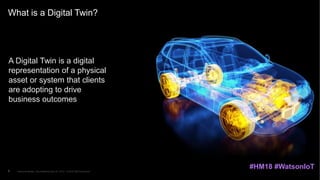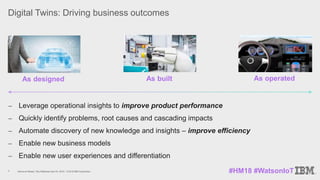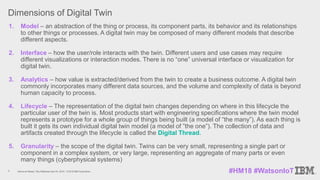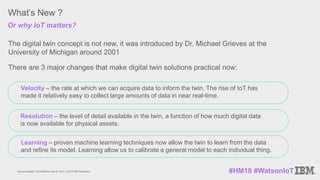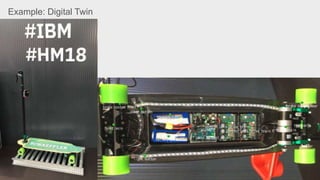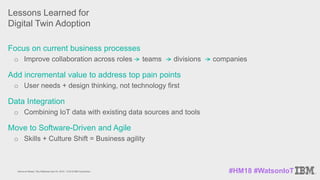Hannover Messe: Evolution of a cognitive Digital Twin
- 1. Twitter Moment from Hannover Messe 2018: https://twitter.com/i/moments/993491931421343744 Sky Matthews CTO, IBM Watson IoT April 24th, 2018 Designing better machines: Evolution of a cognitive Digital Twin Hannover Messe #HM18 #WatsonIoT
- 2. Your Speaker 2 Sky Matthews IBM Watson Internet of Things CTO and Distinguished Engineer Hannover Messe / Sky Matthews April 24, 2018 / © 2018 IBM Corporation #HM18 #WatsonIoT
- 3. What is a Digital Twin? 3 A Digital Twin is a digital representation of a physical asset or system that clients are adopting to drive business outcomes Hannover Messe / Sky Matthews April 24, 2018 / © 2018 IBM Corporation #HM18 #WatsonIoT
- 4. Digital Twins: Driving business outcomes 4 As designed As built As operated ⎼ Leverage operational insights to improve product performance ⎼ Quickly identify problems, root causes and cascading impacts ⎼ Automate discovery of new knowledge and insights – improve efficiency ⎼ Enable new business models ⎼ Enable new user experiences and differentiation Hannover Messe / Sky Matthews April 24, 2018 / © 2018 IBM Corporation #HM18 #WatsonIoT
- 5. Dimensions of Digital Twin 5 1. Model – an abstraction of the thing or process, its component parts, its behavior and its relationships to other things or processes. A digital twin may be composed of many different models that describe different aspects. 2. Interface – how the user/role interacts with the twin. Different users and use cases may require different visualizations or interaction modes. There is no “one” universal interface or visualization for digital twin. 3. Analytics – how value is extracted/derived from the twin to create a business outcome. A digital twin commonly incorporates many different data sources, and the volume and complexity of data is beyond human capacity to process. 4. Lifecycle – The representation of the digital twin changes depending on where in this lifecycle the particular user of the twin is. Most products start with engineering specifications where the twin model represents a prototype for a whole group of things being built (a model of “the many”). As each thing is built it gets its own individual digital twin model (a model of ”the one”). The collection of data and artifacts created through the lifecycle is called the Digital Thread. 5. Granularity – the scope of the digital twin. Twins can be very small, representing a single part or component in a complex system, or very large, representing an aggregate of many parts or even many things (cyberphysical systems) Hannover Messe / Sky Matthews April 24, 2018 / © 2018 IBM Corporation #HM18 #WatsonIoT
- 6. What’s New ? Velocity – the rate at which we can acquire data to inform the twin. The rise of IoT has made it relatively easy to collect large amounts of data in near real-time. Or why IoT matters? The digital twin concept is not new, it was introduced by Dr. Michael Grieves at the University of Michigan around 2001 There are 3 major changes that make digital twin solutions practical now: Resolution – the level of detail available in the twin, a function of how much digital data is now available for physical assets. Learning – proven machine learning techniques now allow the twin to learn from the data and refine its model. Learning allow us to calibrate a general model to each individual thing. Hannover Messe / Sky Matthews April 24, 2018 / © 2018 IBM Corporation #HM18 #WatsonIoT
- 7. Product Lifecycle Management Model-Based Systems Engineering Application Lifecycle Management Formal workflow PR ECR + affected Parts > ECO Discipline collaboration Tasks, Issues Requirements (multiple flavours) Many models UML, SysML, FMU Verification & validation artefacts Product concepts, models Targets, measures7 https://www.youtube.com/watch?v=gUCCnVXgYvw&t=30s Example: Artemis Crystal project digital thread
- 8. Asset Health and Augmented Reality: an IBM Watson IoT Service Offering 8 Integrate Augmented Reality in to your asset management practices ⎼ Partnering with AR headset makers (e.g., DAQRI) Integrating ⎼ Real-time sensor and industrial data ⎼ Asset history ⎼ Predictive analytics ⎼ Weather and other contextual data ⎼ Natural language and voice interface ⎼ Hands-free interaction and guidance Hannover Messe / Sky Matthews April 24, 2018 / © 2018 IBM Corporation
- 9. Example: Digital Twin model of cognitive building 9 IBM Watson IoT HQ Munich Environment ⎼ 600 Room sensors (temp, light, occupancy) ⎼ 250 Smart Meters ⎼ 169 HVAC Machines Digital Twin Model Operational models Building models (BIM) Weather Predictive models Asset models Predictive models Engineering models Cognitive knowledge Specifications and Manuals Asset history www.youtube.com/watch?v=RjuoYJ5ZXcY Sensor Enabled Buildings Detect & Diagnose Anomalies Understand & Learn Energy Consumption Guide Service Technician Hannover Messe / Sky Matthews April 24, 2018 / © 2018 IBM Corporation
- 10. Watson / Presentation Title / Date10 Example: Digital Twin
- 11. Digital Twin Maturity Model 11 Analog, Manual Digitized Predictive, Automated Learning, Reasoning Autonomous, Self-Correcting Hannover Messe / Sky Matthews April 24, 2018 / © 2018 IBM Corporation #HM18 #WatsonIoT
- 12. Lessons Learned for Digital Twin Adoption Focus on current business processes o Improve collaboration across roles teams divisions companies Add incremental value to address top pain points o User needs + design thinking, not technology first Data Integration o Combining IoT data with existing data sources and tools Move to Software-Driven and Agile o Skills + Culture Shift = Business agility Hannover Messe / Sky Matthews April 24, 2018 / © 2018 IBM Corporation #HM18 #WatsonIoT
- 13. Questions? 13 Takeaways to think about: ‒ Who does it serve? ‒ How can we get there incrementally? ‒ What expertise gaps do we have? Visit IBM booth at Hannover Messe / Hall 7 Visit ibm.com/iot Arrange visit to IBM IoT HQ in Munich Sky Matthews CTO, Watson IoT sky@us.ibm.com Twitter: @blueskyflash Hannover Messe / Sky Matthews April 24, 2018 / © 2018 IBM Corporation #HM18 #WatsonIoT
Editor's Notes
- Twitter Moment from Hannover Messe 2018: https://twitter.com/i/moments/993491931421343744
- As some of you have likely seen in the movie Apollo 13, it was an early example of using a twins to experiment and solve some rather complex problems for things that were not within physical proximity to them. If you’re not familiar with the term Digital Twin, it’s one of the most interesting solutions for business today. Digital Twin is not an entirely new concept. It has been popularized through the rise of Industry 4.0 and Industrial IoT and can dramatically transform the way we understand our assets, how they’re used in the real world, how people use them, and what experiences they take away. I could describe its impact in to business it would be agility, loyalty, and quality [note: this line is repeated in speaker notes on following slide] You can make a create digital Twin of a Mars Rover but you can also Twin places or spaces!! You can create digital twins an oil platform or a water pump, an elevator or escalator, a car or cruise ship. Each asset also has a unique story to tell during its life and the story or experience might change dramatically from business to business. Using digital data, we can SEE, LISTEN, TOUCH and experiment and learn more each experience than we could previously and use this to improve design, build and operations. Of course, this digital data, tells only PART of the story! It is our goal at IBM is to help planes, trains, buildings, elevators, pumps and platforms tell their complete story! We believe Digital Twin is the best way for that story to be told! What is the Digital Twin? The digital twin is a virtual representation of a physical object or system across its life- cycle from real-time digital data, and other sources, to enable learning, reasoning, and dynamically recalibrating for improved decision making. Digital twins provide a way to model and manage the complexities inherent in many products today. Many products now have embedded software and therefore processing capability within them, are customizable and require complex manufacturing processes, supply chains and extended value chains to design, develop, produce and service.
- full disclosure: Wikipedia article quotes IBM as one of its sources for this definition. No, I didn’t write the Wikipedia article https://en.wikipedia.org/wiki/Digital_twin
- Genius of Things: An End to End Approach to IoT with Chris O'Connor https://www.youtube.com/watch?v=gUCCnVXgYvw&t=30s



